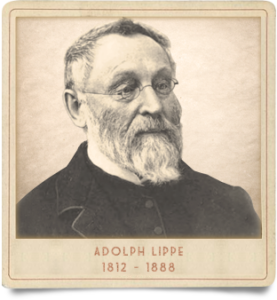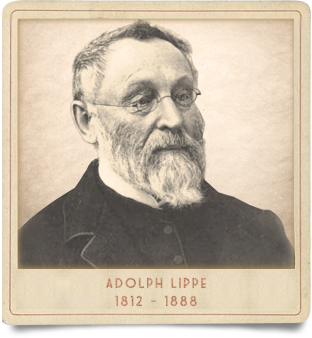 Adolph Graf zur Lippe Biesterfeld Weissenfeld M.D. (11 May 1812 – 23 January 1888) was a singular homeopath and one of the first graduates of homeopathy in America. Lippe taught alongside Constantine Hering at the Hahnemann Medical College in Philadelphia and wrote several very influential books which are still standard textbooks today for modern homeopaths. Lippe also translated many important homeopathic texts, thus enriching American homeopathy.
Adolph Graf zur Lippe Biesterfeld Weissenfeld M.D. (11 May 1812 – 23 January 1888) was a singular homeopath and one of the first graduates of homeopathy in America. Lippe taught alongside Constantine Hering at the Hahnemann Medical College in Philadelphia and wrote several very influential books which are still standard textbooks today for modern homeopaths. Lippe also translated many important homeopathic texts, thus enriching American homeopathy.
Adolph Lippe taught Thomas Lindsley Bradford and many others.
Adolph Graf zur Lippe-Weissenfield was born May 11, 1812 near Goerlitz, in Prussia, and died on January 23, 1888 in Pennsylvania. Dr. Lippe was educated in Berlin and came to the United States in 1837. He first settled in Reading (Berks County), PA and set up practice.
Lippe was the son of Count Ludwig and Countess Augusta zur Lippe, scions of an old and illustrious family, whose estate lay near the town of Goerlitz, Prussia. Here Lippe was born on May 11, 1812.
His parents tried to persuade him to study law, but he had made up his mind to become a homeopathic physician. He received his medical education in Berlin and shortly after his graduation in 1837, he sailed for America and matriculated in the Allentown Academy, the only homeopathic college then in existence.
To further his knowledge, in the fall of 1838 Lippe registered in the first and only homeopathic medical college in the world, the North American Academy of the Homeopathic Healing Art in Allentown, Pennsylvania, also known as the Allentown Academy.
On August 28, 1841 Lippe passed his final examination in front of Drs. Wesselhoeft, Henry Detweiller, Freytag and Romig and graduated with a Doctorate in Homeopathic Medicine. Lippe said that “the possession of an Allentown diploma is an honor to its holder, as it was only obtained by worthy applicants. Many who tried to pass were rejected as incapable.” The Allentown Academy closed soon after this and Lippe was their last graduate.
After this rigorous training, Lippe moved from Reading to Pottsville, PA in 1841 where he practiced with success and growing ability until 1844 when called to a larger field in Carlisle, PA.
J. C Guernsey, the son of H. N. Guernsey, wrote in his rendering of the history of homeopathy in Pennsylvania that “by Dr. Lippe’s labors in Carlisle and the neighboring counties where homeopathy was unknown, he opened a large field for our school.”
Throughout this time, Dr. Lippe made a name for himself with his treatment of various epidemics common in the Cumberland Valley. Then in 1850 Lippe moved permanently to Philadelphia and took two gentlemen from Carlisle with him to pursue the study of homeopathy.
Dr. Lippe held the position of Chair of Materia Medica at the Homeopathic Medical College of Pennsylvania from 1864-1869. He helped launch several of the best homeopathic journals ever to be published, including The Organon, the Hahnemannian Monthly, and the Homeopathic Physician. His unswerving commitment to pure homeopathy was unparalleled, even in his day!
Considered by many to be one of the most clinically successful homeopathic physicians in our great legacy, Dr. Lippe’s multitudinous publications provide a blueprint for homeopathic practice. From his suggestions on how to study Materia Medica to his exposition of Hahnemannian homeopathy, Dr. Lippe gives us incontrovertible evidence of a highly successful homeopathic method.
Lippe had been a regular contributor to homeopathic literature and an active correspondent with his confreres in foreign parts, and more especially with David Wilson in London and Rocco Rubini in Naples.
The correspondence, now turned yellow with the lapse of years, is both interesting and instructive and quite fully attests the warm friendship of many admirers. Rocco Rubini‘s original pamphlet in Italian, introducing the Cactus Grandiflorus, is particularly valuable.
Dr. von Lippe filled the Chair of Materia Medica in the Homoeopathic College of Pennsylvania from 1863 to 1868 and with distinguished success. He also translated valuable Italian, German, and French Homoeopathic essays and treatises, that are now standard.
He augmented and improved the homeopathic meteria medica, and by his clinical reports has shown how this may be rendered practically available and utilized in the application of homoeopathic knowledge and principles.
Lippe was a founding member of the International Hahnemannian Association and he was a colleague of James Tyler Kent, Henry Newell Guernsey, Carroll Dunham and many other famous homeopaths.
Lippe was a fastidious prescriber, often spending hours on a case to get the correct remedy, and he was an advocate high potencies and a staunch defender of Hahnemann’s principles of practicing homeopathy.
Timothy Field Allen compiled the Encyclopedia of Pure Materia Medica over the course of 10 years. It is a comprehensive record of all the provings of homeopathic medicines recorded up to that point…. Constantine Hering, Carroll Dunham, Adolph Lippe, and Richard Hughes all contributed to this monumental work.
Adolph Lippe edited The Organon journal with Thomas Skinner, Samuel Swan and Edward William Berridge in 1878- 1881.
In December 1884 Lippe’s only daughter died, followed just two weeks later by his oldest son, Dr. Constantine Lippe. He never recovered from this double bereavement.
In mid January 1888 Adolph Lippe contracted typhoid pneumonia and died at home in Philadelphia on January 23, 1888.
Select Publications:
- Key to the Materia Medica Or, Comparative Pharmacodynamic (1854)
- Homoeopathic Materia Medica (1864)
- Who is a Homoeopathician?: A Lecture Delivered Before the Hahnemannian Institute, Philadelphia, February 17th, 1865 (1865)
- Cholera: Lecture Delivered at the Homoeopathic Medical College of Pennsylvania, December 8th, 1865 (1866)
- Text Book of Materia Medica (1866)
- Valedictory Address Delivered at the Eighteenth Annual Commencement of the Homoeopathic Medical College of Pennsylvania (1866)
- Liberty of Medical Opinion and Action (1870)
- The Healing Art. A Higher Medical Education. A Reply to Prof. William Pepper, M.D. (1877)
- Cholera; Its Treatment by Homoeopathy (1885)
- What is Homoeopathy: A Lecture (1886)
Of Interest:
Constantine Lippe M.D. (1840 – 1885) was Adolph’s son and he was also a homeopath. He received a serious wound during the American Civil War, when he suffered a shattered fracture of his tibia, and refused amputation. Constantine Lippe graduated alongside notable homeopaths such as Ernest Albert Farrington, Thomas Lindsley Bradford, Edward William Berridge and Walter James, all of whom contributed in major ways to the profession.
Constantine Lippe wrote Repertory to the More Characteristic Symptoms of the Materia Medica (1879). He died of pneumonia on New Years Day 1885, aged just 44, and was buried in Glenwood Cemetery, Washington D.C.



I have a very special pleasure of owning a copy of Lippe’s Textbook on Materia Medica that was personally owned by Constantine Hering, MD. Hering had this book inter-collatated with blank pages so that he could write his additions and corrections to Lippe’s book. Hering gave this book to his student, A.C. Cowperthwaite, another leading homeopathic physician, who took notes from Hering’s lectures and adding select information to the blank pages. Hering then used this book to write his own “Condensed Materia Medica.” (Cowperthwaite wrote the special history of this book on the inner cover of it.)
I own between 1,500 to 2,500 pre-1900 homeopathic books and journals, and I consider my copy of Lippe’s materia medica to be my most prized possession.
If my homeopathic colleagues ever make it to my Berkeley office, please come by to visit this book…and my collection of early homeopathic literature.